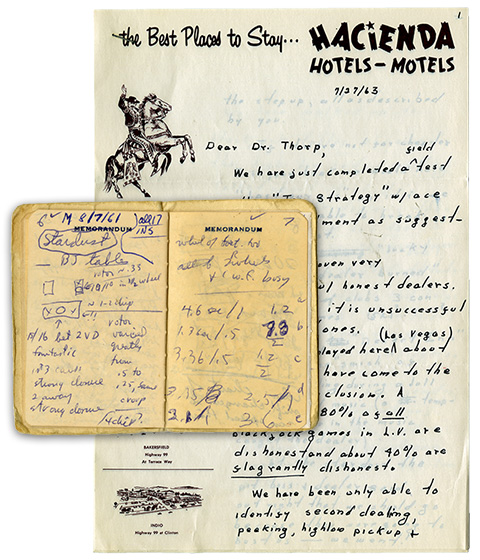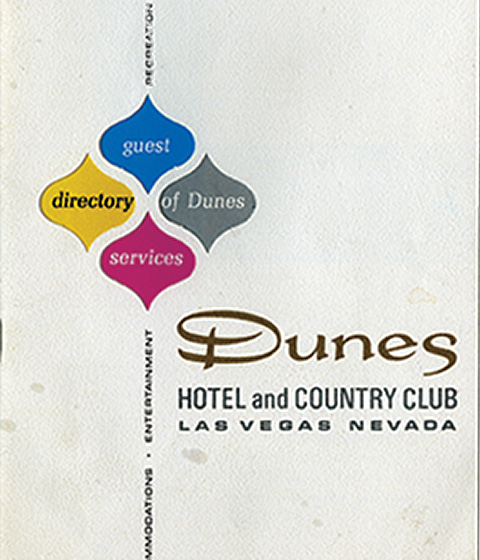“Dr. Thorp may be qualified at mathematics but he is sophomoric in gambling.”
Author unknown. Nevada Gaming Chief Disputes Professor’s ‘All-Win’ System. Denver Post. March 30, 1964
“How the heck do I know how he does it? I guess he’s got one of them mathematical minds or photographic memories, or something.”
This was Cecil Simmons, the casino boss at the Desert Inn, talking on the phone with Carl Cohen, the Sands casino manager. It was the mid-1960s and they were discussing a book that would have a most profound impact on Las Vegas casinos and their approach to the game known as 21 or blackjack.
“All I know,” Simmons roared, “is he wrote a book that teaches everyone how to win every time they play blackjack. I’m just telling you, this book-learning SOB has ruined us . . . we’re out of the blackjack business.”
Author unknown. Counting on Blackjack. Las Vegas Style. May 5, 1993.
Response to Beat the Dealer: A Winning Strategy for the Game of 21 from the casinos.
On April 1, 1964, the Nevada Resort Hotel Association announced they were changing the rules of blackjack. Splitting pairs and doubling down would be restricted and the deck of cards would be reshuffled after just a couple of deals. This significantly increased the house advantage. As Edward O. Thorp predicted, these rule changes were incredibly unpopular with both card counters and non-card counters. People stopped playing blackjack and the casinos had no choice but to reinstate the original rules.
“...I forged a system for beating the game. Then I was ridiculed by the casino beast . . . I found myself barred, cheated, … and generally persona non grata at the tables. It felt good to know that, just by sitting in a room and using pure math, I could change the world around me.”
Edward O. Thorp. A Man for All Markets: From Las Vegas to Wall Street, How I Beat the Dealer and the Market. Random House Publishing Group, 2017. Page 111.
Six-deck Shoe and Discard Tray.
Traditionally red or black resembling a woman’s high heel shoe, a “dealing shoe” is commonly used in casino’s to hold multiple decks of playing cards. Until the early 1960s, single-deck blackjack was the standard in Nevada, 4 and 6-deck shoes, casinos’ theorized, would thwart card counters as multiple decks made it harder to keep accurate track of the deck.
Edward O. Thorp’s response, “[4, 6, 8-deck shoes] were supposed to make card counting more difficult. But for those who used the High-Low System, it wasn’t much harder.” Edward O. Thorp. A Man for All Markets: From Las Vegas to Wall Street, How I Beat the Dealer and the Market. Random House Publishing Group, 2017. Page 113.
“The green felt table was a stage and I was an actor on the stage. A card counter who wanted to be allowed to continue playing had to put on an effective act and present a nonthreatening persona.”
Edward O. Thorp. A Man for All Markets: From Las Vegas to Wall Street, How I Beat the Dealer and the Market. Random House Publishing Group, 2017. Page 108.
Letter written by Edward O. Thorp. April 6, 1963.
“I was successfully disguised and not recognized.”
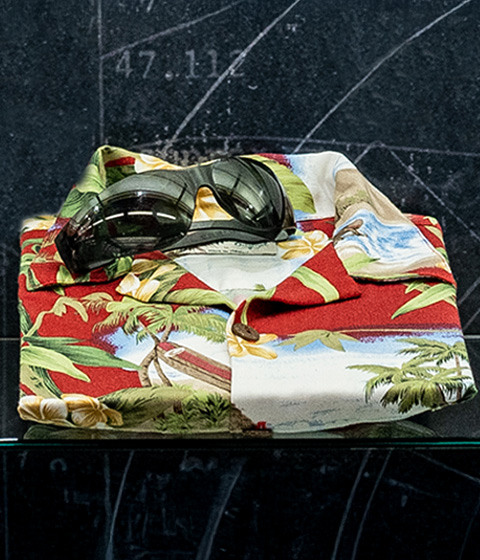
Disguise Paraphernalia.
As Edward O. Thorp begins to win too often and is recognized as the author of the book, Beat the Dealer, he is repeatedly asked to leave casinos. Casinos are considered to be private clubs and can exclude whomever they please.
To get around being barred from casinos, Thorp experimented with disguises, including contact lenses, sunglasses, a beard, and drastic changes of wardrobe and table behavior.
In A Man for All Markets: From Las Vegas to Wall Street, How I Beat the Dealer and the Market (2017), Thorp recalls an encounter with one disguise, “When I introduced myself… they saw a bearded fellow wearing a brightly patterned Hawaiian shirt, wraparound sunglasses, and jeans… [Later on] I decided to put my disguise to the acid test...I shaved off the beard, replaced the prescription sunglasses with contact lenses, and combed my hair differently. A sports jacket and tie completed the transformation. I had no problem playing in the establishments that had barred my bearded self just the day before” (pages 107-108).
Cheating by the Casinos.
Collection of letters and notes to and from Edward. O Thorp and newspaper article discussing cheating by casinos. From the UCI Libraries Special Collections and Archives, Edward. O Thorp Papers.
Common cheating practice, “Peek at the next card to be dealt, the so-called top card. Then if that card was good for the player, deal the card just below it instead, the second card, in the likelihood it was worse. On the other hand, if the dealer was giving a card to himself, he would take the top card if it was good for him, and otherwise deal himself the second. The dealer who does this is a heavy favorite to beat the player… It is also nearly impossible to prove it ever happened. Cheating was so relentless during those days in Las Vegas that I spent as much time learning about the many ways it was being done as I did playing. Everywhere we went, we reached a point where we were cheated, barred from play, or the dealer reshuffled the cards after every hand.” Edward O. Thorp. A Man for All Markets: From Las Vegas to Wall Street, How I Beat the Dealer and the Market. Random House Publishing Group, 2017. Pages 102-103.
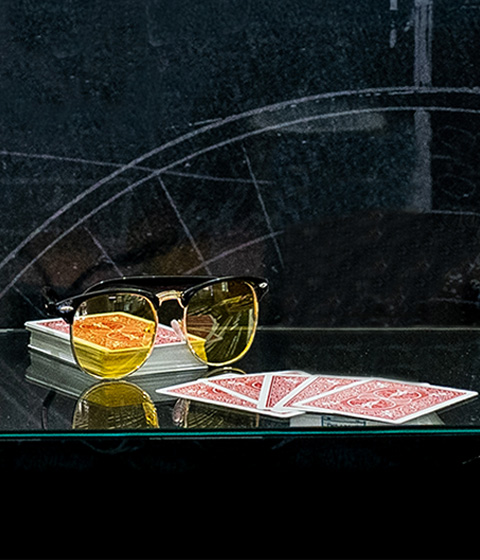
Marked Cards + Yellow Glasses.
As Edward O. Thorp begins to win too often and is recognized as the author of the book, Beat the Dealer, he is repeatedly asked to leave casinos. Casinos are considered to be private clubs and can exclude whomever they please.
One way dealers would cheat is they would wear yellow tinted glasses, through which they could see identifying marks on the back of the cards. If the card on top was a good card for the player, the dealer dealt him the next card, or “second” instead.
This pack of cards has identifying marks on the back that you do not need glasses to detect. Can you see them?
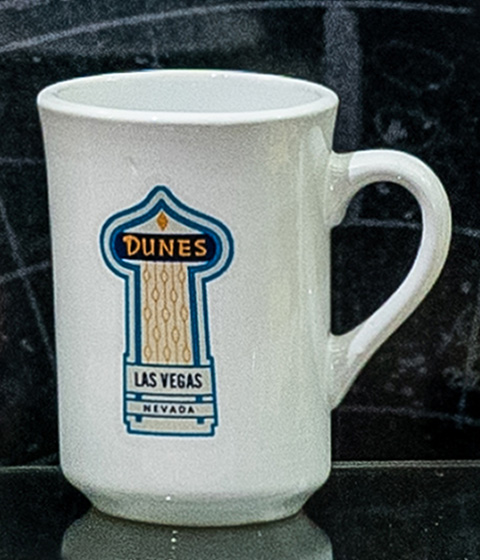
Drugged coffee mug at Dunes Hotel while playing Baccarat in 1963.
After figuring out blackjack, Edward O. Thorp turned his attention to other casino games. Baccarat has similarities to blackjack and therefore was the next logical game to tackle. During a trip to Las Vegas in 1963, Thorp did very well playing baccarat. On the third night, it seems that the casino decided to put a stop to this.
“The pit boss and his minions seemed pleased to see me. Then they volunteered ‘coffee with cream and sugar, just the way you like it.’ I was deep into the first shoe happily winning and drinking my coffee when suddenly I couldn’t think. I could no longer keep count...The wives saw that my pupils were hugely dilated. A nurse said that she had seen this often when people who had used drugs were admitted to her hospital...” Edward O. Thorp. A Man for All Markets: From Las Vegas to Wall Street, How I Beat the Dealer and the Market. Random House Publishing Group, 2017. Page 142.
Despite that incident, Thorp was satisfied that his theories about side bets and how to take advantage when there are fewer cards in the shoe were correct. Thorp said, “We had proven the system worked at the tables like it did in theory. As a result, both the Dunes and the Sands removed the natural 8 and natural 9 bets.” Edward O. Thorp. A Man for All Markets: From Las Vegas to Wall Street, How I Beat the Dealer and the Market. Random House Publishing Group, 2017. Page 144.
10 Count Strategy for One Deck
What to Count:
- Start with the count of 0.
- Add +4 for the following cards: Ace, 2, 3, 4, 5, 6, 7, 8, 9.
- Subtract -9 for the following cards: 10, Jack, Queen, King.
- Explanation: Start with the minimum bet. As the count gets higher, increase your bet. When the count starts to return to 0 or go negative, you should lower your bet to the minimum.
- Question: Given this scenario, would you bet more or less on your next hand?




